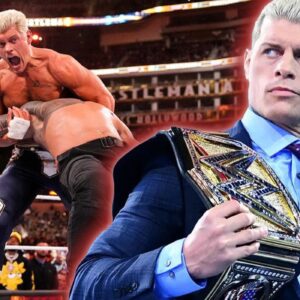
There are few pro wrestlers, past and present, male or female, that have walked the path Natalya Neidhart has. A 20-plus-year veteran of the squared circle, multiple Guinness World Record holder, multi-time champion of almost every WWE Championship in the women’s division, and longest-tenured female WWE competitor, what hasn’t Natalya done?
And with a career as long as Nattie Neidhart’s, you can bet she’s been privy to pro wrestling happenings both infamous and unknown. One of those events is perhaps the most notorious: The Montreal Screwjob.
There’s no need to rehash the events that occurred during the main event of the 1997 Survivor Series. We’re aware of the false submission; the spit; the backstage punch; Vince McMahon’s red-faced “Bret screwed Bret!” mantra in the aftermath. Neidhart was young then, just a teen. But, the incident rocked the WWE, pro wrestling, and of course, The Hart Family.
In an exclusive interview with The Takedown On SI, Neidhart ruminated on The Montreal Screwjob, specifically the difference between HBK the performer, and Shawn Michaels the head of NXT, WWE’s developmental system and weekly program.
“Well, it’s funny because Shawn, when I was a little girl growing up, I was probably eight years old. I would watch my dad and Bret and they would take on The Rockers, Shawn and Marty,” Neidhart said.
“When I first got to meet Shawn Michaels, it was actually debuting on the main roster in WWE. I got signed in 2007 and he was, I think, at the very tail end or nearing it. I can’t remember exactly when he retired from actual in-ring wrestling, but he was still doing it.”
Neidhart is married to TJ Wilson (aka Tyson Kidd), former WWE performer, graduate of the original Hart Dungeon, current WWE producer, and a fantastic performer in his own right. Neidhart said it was Wilson who helped “bridge the gap” between Michaels and Hart.
“TJ had said something to Bret like, ‘I had a really great talk with Shawn and he was awesome and he was so nice to me and he was so nice to Nattie and he was just such a cool guy. He was giving me advice and being really helpful. Shawn had said that he had felt so bad about everything that had happened with you guys in the past,'” Neidhart said of Wilson’s conversation with Bret Hart.
“TJ was the one that opened up (the) conversation between Bret and Shawn for them to kind of reconcile,” Natalya said.
“So, we can all thank TJ for being the person that opened up that door because TJ is somebody that Bret really respects, and (he) trusts his word. Shawn was so nice to us and I think Shawn for a long time felt, you know, I think he felt bad.”
It’s arguable that WWE in the 80’s and 90’s was the most cutthroat, competitive locker room in the history of the business. The company was expanding on an enormous level and TV time was more precious than ever. With the pressure to perform at a high level, egos, and unchecked drug use, it’s a miracle that WWE was able to succeed during that time.
“Back in that era with Shawn and Bret, the 80’s, the 90’s, the early 2000’s, the attitude era–those guys were fighting for their lives. They were fighting for TV time. There was a lot of money at stake. Everybody was just fighting for their spot and so it was a different time,” Neidhart said. “It wasn’t like the way it is now. I feel it’s a lot kinder and a lot more about people as human beings. Back then it was very cutthroat.”
“Shawn was in a different place in his life. Bret was in a different place in his life. Shawn felt very remorseful, and so when I ended up working with Shawn at NXT, he was wonderful. He’s a dream promoter.”
HBK is one of the greatest performers the wrestling industry has known. He’s on many a Mount Rushmore and his experience is invaluable, especially to the next crop of WWE talent. NXT couldn’t have a better person in charge of creative. Natalya agrees.
“Shawn is so encouraging to everyone. He makes you feel so good after you get back, so happy and so good about yourself,” Neidhart said. “I honestly just had the best experience at NXT. And I’m always excited about the opportunity of going back.”





